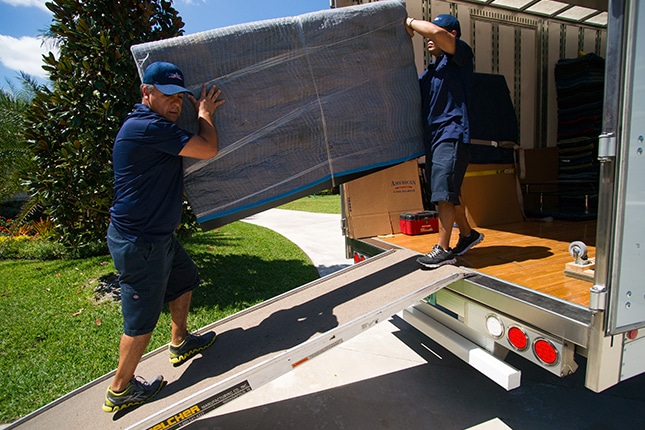Local Moving Services: Specialist Relocation Specialists Can Help Make Your Shift Smooth And Hassle-free
History and Advancement of Moving Services
The Dawn of Moving: From Muscle to Devices
Photo this: a handful of strong guys carrying heavy trunks on wood carts, browsing cobblestone streets with sweat and decision. Before the modern-day moving market took shape, moving was a harsh, labor-intensive task. In ancient times, relocation frequently suggested depending on large physical strength and primary tools. The lack of specialized services suggested households and merchants had to coordinate every information themselves, often risking damage or loss.
Isn't it fascinating how need fuels development? As cities broadened and commerce thrived, the requirement for efficient, reputable moving options ended up being glaringly apparent. Enter the period of horse-drawn wagons and later on, motorized automobiles, which reinvented how personal belongings traveled from one place to another.
Industrial Transformation: The Catalyst for Change
The 19th century's commercial boom improved lots of facets of life, consisting of how people moved. check here All of a sudden, city migration rose, and with it, the need for expert movers skyrocketed. No longer was moving a basic chore; it developed into a specific service offering:
- Packaging proficiency to protect delicate items
- Organized loading techniques optimizing space
- Transportation options tailored to various ranges
This duration marked the birth of companies devoted entirely to moving, preparing for today's complex logistics and customer-centric approaches.
Technological Developments and Their Effect
Can you imagine moving without modern devices? The arrival of hydraulic lifts, forklifts, and pallet jacks transformed the market overnight. Unexpectedly, movers could handle bulky furniture and heavy devices with ease, minimizing injuries and enhancing performance.
Additionally, the combination of digital technology sparked a new age of innovation. GPS tracking, online reservation platforms, and real-time stock management have ended up being staples in the moving services landscape. These tools not only improve openness but likewise empower customers to remain linked and notified throughout their moving journey.
Key Milestones in Moving Provider Advancement
| Age | Advancement | Significance |
|---|---|---|
| Ancient Times | Manual labor and fundamental carts | Structure of moving as a requirement |
| 19th Century | Horse-drawn wagons and packaging services | Birth of professional moving companies |
| 20th Century | Motorized trucks and mechanized equipment | Increased efficiency and scale |
| 21st Century | Digital combination and GPS innovation | Enhanced consumer experience and logistics |
Reflections on the Journey
Assessing the development of movers, one might wonder: how did an easy act of carrying possessions become a sophisticated industry? It's a tale of durability, adaptation, and continuous improvement. From the sweat-soaked streets of old to the precision-driven operations of today, the history of moving services is as vibrant as the individuals who depend on them.
Next time you pack a box or employ a mover, think about the layers of history ingrained in every action. The journey of movers encapsulates human ingenuity, transforming what was when a complicated job into a seamless experience.
Exploring the Spectrum of Moving Services
When the time comes to shift your life from one address to another, the range of moving services offered can seem like navigating a labyrinth. Do you need a basic loading and dumping team, or does your relocation demand the finesse of complete packaging and unpacking? Comprehending the subtleties can conserve hours of aggravation and unexpected costs.
Typical Kinds Of Moving Providers
- Regional Moves: Designed for movings within a city or city, these services normally run on a per hour basis, ideal for brief distances.
- Long-Distance Relocations: Covering moves beyond 100 miles, these need more coordination, from logistical planning to secure transport, often priced by weight and range.
- Full-Service Relocations: Movers manage whatever-- packing, loading, transporting, unloading, and sometimes even unpacking. Perfect for those pressed for time or energy.
- Self-Service Moves: You load and load your possessions, while the company manages transportation and dumping. A happy medium offering cost savings and some convenience.
- Specialized Relocations: For vulnerable, bulky, or important items like pianos, antiques, or artwork, requiring customized equipment and proficiency.
Specialist Tips to Navigate Your Moving Service Choices
- Prioritize Versatility: Select a service that adjusts to unexpected hold-ups or last-minute changes-- rigid schedules can turn a smooth relocation into a logistical problem.
- Inspect Insurance Options: Not all moving business supply the exact same level of defense. Understanding your protection can avoid distress if something goes awry.
- Demand Detailed Inventories: An accurate product list avoids conflicts and makes sure responsibility, especially when handling long-distance or specialized relocations.
- Consider Time of Year: Seasonal need can affect schedule and rates. Early scheduling during off-peak seasons might approve much better service and versatility.
- Ask About Packing Products: High-quality boxes, bubble wrap, and padding can be the difference between a scratched heirloom and a beautiful arrival.
Table: Service Features Compared
| Service Type | Who Loads? | Transport Mode | Normal Rates Design | Perfect For |
|---|---|---|---|---|
| Regional Move | Consumer or Movers | Truck | Hourly | Brief distances, little loads |
| Long-Distance Move | Movers | Truck or Container | Weight & & Range | Cross-state or regional relocation |
| Full-Service Move | Movers | Truck | Flat or Weight-Based | Time-sensitive, high-stress relocations |
| Self-Service Move | Client | Truck or Container | Flat or Hourly | Cost-conscious, hands-on movers |
| Specialized Move | Movers with competence | Specialized Equipment | Custom-made Quote | Fragile or important products |
The Unseen Intricacy Behind Each Choice
Have you ever questioned why moving appears uncomplicated on television but turns into a cascade of last-minute decisions in reality? The fact depends on the complexities of each service type. Full-service relocations might seem like a high-end, but the expertise involved in packing fragile heirlooms or dismantling bulky furniture is a craft honed over years. Choosing for a self-service relocation might conserve cash, however it requires a keen understanding of how to load efficiently-- did you understand that stacking oddly shaped boxes incorrectly can trigger internal shifting during transit, damaging fragile contents?
Choosing the right type of moving service is not practically benefit-- it's about protecting your memories and financial investments. What's your relocation's story going to be?

Packing and Moving Strategies
Ever attempted to fit a travel suitcase that just won't close? That's the sort of puzzle expert movers fix daily-- however on a much bigger scale. The secret lies not in strength however in strategic positioning and smart use of area. Packing isn't simply about stuffing products into boxes; it's an art kind where every inch counts.
Layering for Success
Imagine a painter layering colors to develop depth. When packaging, start with heavier products at the bottom, then cushion with softer products like bubble wrap or towels. This prevents damage and makes the most of box stability. Strangely formed items can slip into spaces, decreasing wasted space.
- Wrap fragile products separately with tissue or foam to prevent scratches.
- Usage clothing as padding-- it's both effective and eco-friendly.
- Fill voids with packing peanuts or crumpled paper to minimize movement.
Labeling: The Unsung Hero

What excellent is ideal packing if you invest hours searching through boxes? In-depth labeling is a game-changer. Instead of unclear tags like "Kitchen," attempt this approach:
| Label | Description | Top priority |
|---|---|---|
| Fragile - Glass wares | Handle with care, includes delicate products | High |
| Fundamentals - Very First Night | Items needed right away after moving | Immediate |
| Books - Study Room | Stacked, heavy books | Medium |
Strategic Packing Tips
- Disassemble large furniture and keep screws in labeled bags taped to the pieces.
- Use uniform box sizes when possible-- stacking ends up being easier and much safer.
- Don't overpack boxes; weight limits exist for a reason. Goal for 40-50 pounds max.
- Wrap furniture edges with moving blankets to prevent scratches during transit.
- Seal boxes with high-quality packaging tape-- double layers on the bottom are important.
Why do some movers swear by a color-coded system? Because it gets rid of guesswork on moving day. Appoint each room a color and mark boxes appropriately. This little step can conserve hours when unloading and unloading.
Packing and moving demand precision-- like a chess video game where every relocation counts. Have you ever noticed how some movers deal with large items effortlessly? They leverage angles and pivot indicate navigate tight corners without damage. It's not muscle; it's strategy.
Hidden Struggles Behind the Moving Van Doors
Ever enjoyed a group of professional movers carry a grand piano through a narrow entrance and wondered how they pull it off without a scratch? The art of moving isn't just muscle and trucks; it's a delicate dance with unpredictability. Weather can turn from a sunlit true blessing to a torrential menace in minutes, turning an uncomplicated drive into a logistical labyrinth.
One well-known hurdle is the labyrinthine layout of some homes or homes. Staircases too tight for dollies, doorways narrower than standard boxes, or elevators that hardly fit a sofa-- these physical quirks require inventive solutions on the area. Movers often turn to unconventional tactics like taking apart furniture or utilizing personalized padding to secure both the item and the residential or commercial property.
Precision Packaging: More Than Just Wrapping
It's tempting to believe packaging is simply stuffing boxes, however the truth is a complicated puzzle of weight distribution and fragility. Movers should expect how products will move during transit-- a mistake can indicate shattered treasures or dented devices. The secret weapon? Strategic layering and utilizing materials with specific shock-absorbing qualities.
- Bubble wrap is standard, but alternating it with foam sheets can significantly decrease impact damage.
- Heavy products go at the bottom; fragile ones nestle on top, cushioned by soft textiles.
- Labeling boxes not simply by contents however by managing directions ensures quicker, more secure unloading.
Another less talked about strain is the mental toll. The clock ticks relentlessly, and every delay ripples through tight schedules. Remaining calm in the middle of disorderly last-minute modifications needs psychological dexterity and group synergy.
Traffic Jams and Timing: The Undetectable Challengers
| Obstacle | Professional Technique | Effect |
|---|---|---|
| Urban blockage | Route optimization apps and flexible scheduling | Decreases hold-ups and fuel consumption |
| Parking limitations | Pre-arranged licenses or strategic parking close by | Prevents fines and time loss |
| Unpredictable weather | Water resistant coverings and contingency strategies | Maintains the condition of goods and equipment |
Do you really know what it requires to keep a moving day on track? It's not almost strength or stamina; it's about insight, versatility, and a deep understanding of every piece of the puzzle. The next time you see movers at work, keep in mind: behind that seamless operation lies a series of calculated maneuvers and quick thinking that couple of ever notice.